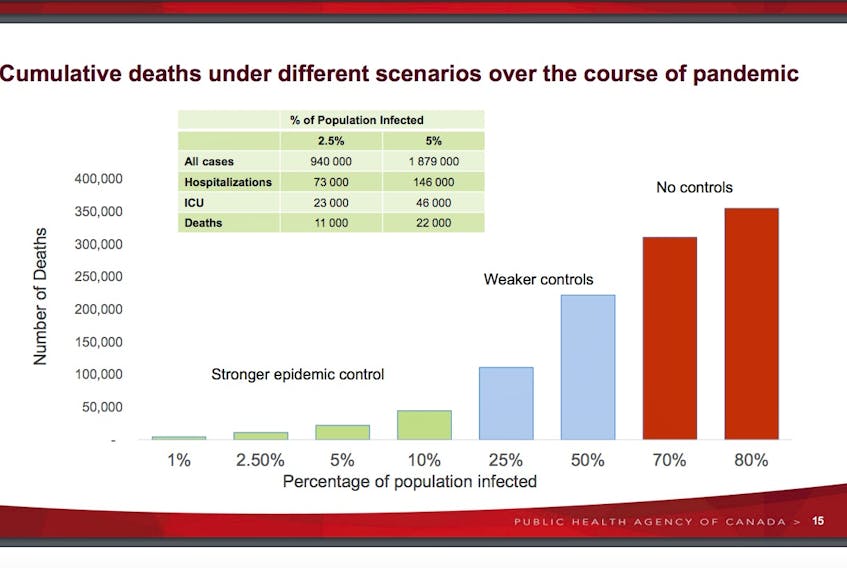Among the millions of words of reportage during the nightmarish COVID-19 pandemic, a recent quote from one expert — a statistician — stands out, that people generally “don’t understand the concept of risk.”
Poor John Haggie, our haggard-sounding health minister, is obviously exasperated, admonishing people this week to stop behaving like children and start obeying the physical distancing rules that are necessary to slow the spread of the coronavirus.

He is up against the long-recognized problem of numeracy illiteracy. Many people, possibly most people, have trouble with numbers.
The worst offenders are those — on social media and in the comments section of The Globe and Mail and National Post — who claim the danger of the pandemic is exaggerated and the lockdown/shutdown is an overreaction, because the coronavirus apparently kills “only” two per cent of those it infects.
One idiot — excuse the name-calling, but in this instance it fits — even commented, “If I get it, I have only a two per cent chance of dying.”
Imagine the frustration of that guy’s math teachers.
Others have phrased the same idea more positively: of every 100 people infected with the coronavirus, 98 will live. So, what’s the big deal?
As per the statistician’s observation, these people have no concept of risk.
Anyone who thinks this way needs to put the numbers into visuals. Here’s one that might be helpful: bring to mind the famous scene in “The Deer Hunter” in which Robert De Niro and Christopher Walken are forced by their Viet Cong captors to play Russian roulette.
Now, picture yourself in a similar game, say, coronavirus roulette. Of course, instead of a bullet in one of the six chambers, there’s a gun with 50 chambers, and one has a bullet.
A skeptic at the back has his hand up. Yes, sir?
“In this analogy, shouldn’t it be a 100-chamber gun with two bullets?”
“Sir, 50-to-1 is the same probability as 100-to-2.”
“Oh, OK. Never mind.”
Now, where were we? Oh yes, the 50-chamber gun with one bullet, coronavirus roulette. Would you be nervous if you played?
Here’s a way to put it in perspective. Millions of people play the lottery. For a couple of bucks you buy a pretty good chance of becoming a millionaire. Sure, the odds are about 10 million to one, but somebody has to win, right? Why couldn’t it be me?
On the one hand, 10,000,000-to-1 is good odds. On the other hand, 50-to-1 is impossible odds. Listen to the statistician. Learn about the concept of risk.
Here’s a scenario for sports fans. The Habs and the Maple Leafs are playing each other in the Stanley Cup final, and the series is tied 3-3. Unfortunately, all the Zambonis in Montreal and Toronto have broken down, so they’ve shifted Game 7 to Mile One Centre in St. John’s.
Demand for tickets is astronomical. Public health officials have warned that about two per cent of those who attend the game will die from sheer excitement.
Rounding off the sold-out crowd to 6,200, there will be 124 fans taken away in body bags. Would you go? More importantly, would you take the kids?
Leafs fans, suffering a half-century of losing, might risk it, but rational people would tear up their tickets.
But that’s enough of make-believe analogies. The numerically challenged and any of their brethren who think a two per cent mortality is no big deal should read, or at least skim, the 19-page report put out last week by the Public Health Agency of Canada.
The report contains shocking numbers that are based on science and mathematics — probabilities and percentages.
Even with the strong control measures that Haggie talks about every day — physical distancing, isolation and quarantine — between 11,000 and 22,000 Canadians will die from COVID-19 during the pandemic, according to the Public Health Agency of Canada.
Without those efforts to control the spread of the coronavirus, between 300,000 and 350,000 Canadians would die during the pandemic, the agency reported.
So, no, two per cent is not insignificant. The risk is not insignificant.
And, for crying out loud, will all the numerically challenged armchair epidemiology experts please stop saying, “It’s no worse than the flu.”
Brian Jones is a desk editor at The Telegram. He can be reached at [email protected].









